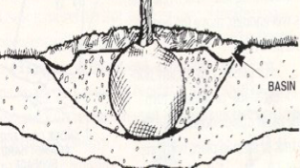Step 1 – Prepare the Hole
Plant the tree no deeper than the root ball is tall. Dig the hole 18” to 24” wider than the root ball. If the soil is compacted, a hole 3 to 5 times the width of the root ball is recommended. The sides of the hole should be clopped and roughed up to promote root growth.
A common mistake in planting is to over-dig the tree hole. Adding loose soil under the root ball to bring the tree to proper level can cause the tree to sink and drown once the root ball is moistened. Fill the plant hole with water while preparing the site to eliminate air pockets in the soil.
If planting in poorly-draining soil, the hole may be dug so that up to one-third of the root ball is above the ground. To determine if you have a poorly-draining soil, fill the plant hole with water. If it fails to drain within 24 hours, the soil is poorly draining.

Step 2 – Set the Tree
- Cut away or otherwise remove any root ball packaging.
- Cut and remove twine from around the trunk and root ball.
- Remove the burlap bag, if present.
Step 3 – Backfill the Hole
A soil test is best for determining if soil amendments should be added to the tree planting site. Organic amendments are best for trees as manures tend to be high in urea which can burn new roots. Before backfilling with soil amendments, file the hole with water to eliminate air pockets.
Build a watering basin from surrounding soil. Raise the edges of the basin about 4 inches and compact the sides to prevent erosion.
Step 4 – Add Mulch
Organic materials make the best mulch. Read more about mulching.
Step 5 – Staking
Young trees may require staking during their first growth season to make sure they anchor properly in the ground. Stakes should be soft and loosely connected so not to damage the tree. Refer to the Staking section at this site for more information.
Tree Topic: Planting New Trees
Arbor Day’s website has several helpful tree planting videos
Check out the New Tree Planting Guide from International Society of Arboriculture
